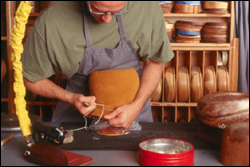Jan Davidson had two days to make Oprah happy.
Her production company was shooting a TV movie and the producer desperately
needed a woman's wedding hat. Davidson got the job with no time to spare.
The hat had to be on the set by Monday morning, and it was already Friday.
But this was not just any old hat. Some 1,000 small silk flowers were to garnish
it, and Davidson had to stitch each one not with a sewing machine, but by
hand.
"I practically spent 48 hours with my eyes open and my hands practically
bloody making this hat," says Davidson. She is a milliner in North Carolina.
"It was a very, very intricately made hat. But it was well worth it, and it
was well received."
It was also a major career highlight for Davidson. She credits her two
grandmothers for starting her career in millinery, the art and craft of making
hats for women.
Although they were not milliners, they gave Davidson a love for working
with her hands. "And I have always loved design, color, style and form --
all those things. And I have dabbled in so many different things, like silk
ribbing, embroidery and crocheting."
And yes, Davidson collected hats as she was growing up.
Those interests came together in 1995 when she and her husband moved to
Australia. Stays in Brisbane and Melbourne exposed her to the complex and
colorful world of millinery. She soon enrolled at the Melbourne School of
Millinery, one of the few schools to offer formal education in that field.
 |
| Milliners work with their hands to design and create unique hats
for women. |
| Courtesy of: Wayne Wichern |
"It pulled all those things together," she says. "So for me, [millinery]
is not only something I do to make money, but it is also a very strong creative
outlet. The creative part is just as much a motivator as making money from
sewing. It is working with my hands and creating something."
And as any artist will tell you, creating something new is an often frustrating
and exhausting struggle.
Davidson says she usually has a firm idea of how she wants a hat to look.
"But it is amazing how many times a hat will take on its own life. It won't
be what I want it to be. It is only going to be what it wants to be."
She still recalls the agony she experienced over a hat she made for a local
store. "This hat took on three different lives," she says. "We fought the
entire time. It went to the shop three different times as three different
hats. I was never pleased with it."
Davidson eventually just went along to where creativity took her, and the
hat sold the day after she had brought it to the store.
This artistic struggle is part of a greater struggle to survive in a field
that has existed on the fringes of the fashion world. That has not always
been the case.
For the first half of the 20th century, everybody wore hats and dressed
up for most social occasions, including baseball games. But the economic boom
of the 1950s gave the public more time and money for recreation and leisure.
Soon Hawaiian shirts and baseball caps began to replace dress shirts and hats.
This dressing-down reached a climax in the 1960s as the social and sexual
revolutionaries branded hats symbols of the oppressive establishment. "The
millinery business was just booming in the 1930s, 1940s and 1950s," says Wayne
Wichern. He is a milliner in Seattle. "In the 1960s, it crashed."
It picked up again in the 1980s when stocks and hairdos rose to new and
tacky heights. It has continued to grow since, but it will never be what it
was because North American society continues to become more casual in dress
and manners.
Wichern says we have become a hugely casual society because our lives have
become more complicated.
The logic is simple: the more complicated our lives become, the less time
and money we want to spend on clothes and headwear. Instead, we want to dress
in a way that does not require a lot of time, effort and money.
This has made it difficult for people like Wichern to make a living, and
he has to supplement his income by teaching his craft to others.
Efstathia Xynnis also feels comfortable in her little millinery shop, and
she doesn't think her trade is antiquated. "I don't feel out of place," she
says. "People still have a need for things that are customized, or more specially
made. They don't want ready-to-wear [hats]. It doesn't suit them. It doesn't
fit them. They don't like it. They want more."